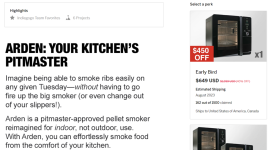You are using an out of date browser. It may not display this or other websites correctly.
You should upgrade or use an alternative browser.
You should upgrade or use an alternative browser.
The Arden Indoor Smoker
- Thread starter G Mouser
- Start date
Joe Anshien
TVWBB Honor Circle
Well since they are not for sale yet and very little details, I would say it is vaporware right now.
Jepprey P
TVWBB Fan
If I was in a living arrangement that didn't allow for charcoal smokers, such as apartments, condos, townhouses, etc., I'd consider it. Only if I was living in a big city, though.
Otherwise, I'd pack one of my Weber grills (maybe the 14" WSM or the WGA if I needed to go light) into the vehicle and head for the local park.
Barring those options, I would use one of those stove-top indoor smokers if I had a good oven range hood.
Otherwise, I'd pack one of my Weber grills (maybe the 14" WSM or the WGA if I needed to go light) into the vehicle and head for the local park.
Barring those options, I would use one of those stove-top indoor smokers if I had a good oven range hood.
Bob H.
TVWBB Hall of Fame
So, where does the smoke go?Thoughts on this ....
Jepprey P
TVWBB Fan
I have no idea.So, where does the smoke go?
The web site (https://firstbuild.com/products/indoor-smoker/) states that its ventless filtration technology is based on its Monogram Hearth Oven (https://appliances.monogram.com/us/specs/ZEP30FLSS - starting at $12K).
In the video posted above, the woman states that the hearth oven has a “special system inside that absorbs the smoke during the cooking process” and this “special smoke-trapping technology was safely nestled” into the prototype indoor smoker.
I don't think the "special system" traps or absorbs the smoke, rather I think the system acts like a motor vehicle three-way catalytic converter, where it takes care of the three main emissions of a vehicle (nitrogen gas, carbon dioxide, and water vapor - https://auto.howstuffworks.com/catalytic-converter.htm) by speeding up chemical reactions to reduce those emissions.
To compare, the three main emissions of a wood fire are gasses, solids, and liquids (https://amazingribs.com/more-techni...ring/what-you-need-know-about-wood-smoke-and/).
For the Monogram Hearth Oven, I looked at the owner's manual (https://products.geappliances.com/M...ispatcher?RequestType=PDF&Name=49-80785-2.pdf) "Care and Cleaning" section and didn't see any filter replacement requirements, which also supports the catalytic converter theory.
Like cars, this indoor smoker will likely have a fuel management system with sensors to read parameters (ambient air temp, pit temp, etc.) to adjust the air to fuel ratio from lean to rich to make sure all of the fuel will be burned using all of the oxygen in the air. If I had to guess, this countertop indoor smoker will retail in the $3-4K range...maybe more.
Jepprey P
TVWBB Fan
@Bob H. in this FirstBuild YouTube video:So, where does the smoke go?
The company answers the question "where does that exhaust (smoke) go?"
They call the component on the back of the unit a "smoke eliminator" (0:52 second mark). ("It pulls the smoke through the smoke eliminator and exhausts it right out the back.")
The next question is "where does that exhaust go - are we going to need a vent for the air coming out of the back of the unit?" (0:57 second mark.)
The response is, "well no, the smoke eliminator eliminates all the smoke and just CO2 and water vapor come out of the back of the unit."
That fits my catalytic converter theory. I just wish I would've watched their videos first before researching combustion and catalytic converters.
Oh well, I learned something regardless.
Jepprey P
TVWBB Fan
Well, I was wrong on the price. The Arden is now live on Indiegogo and is going for $649, 40% off of a $1,099 list price.
Shipping is estimated for August 2023.
(https://www.indiegogo.com/projects/arden-the-indoor-pellet-smoker#/)

Shipping is estimated for August 2023.
(https://www.indiegogo.com/projects/arden-the-indoor-pellet-smoker#/)

Joe Anshien
TVWBB Honor Circle
That is a very attractive price. I really think you should jump on this and let us know how it goes;-)Well, I was wrong on the price. The Arden is now live on Indiegogo and is going for $649, 40% off of a $1,099 list price.
Shipping is estimated for August 2023.
(https://www.indiegogo.com/projects/arden-the-indoor-pellet-smoker#/)
View attachment 48198
